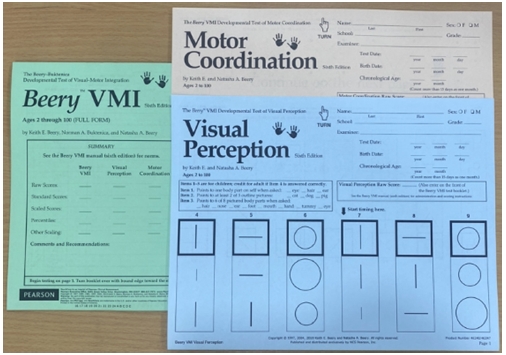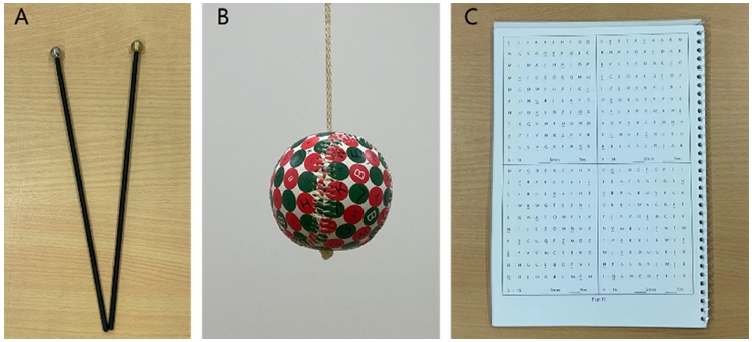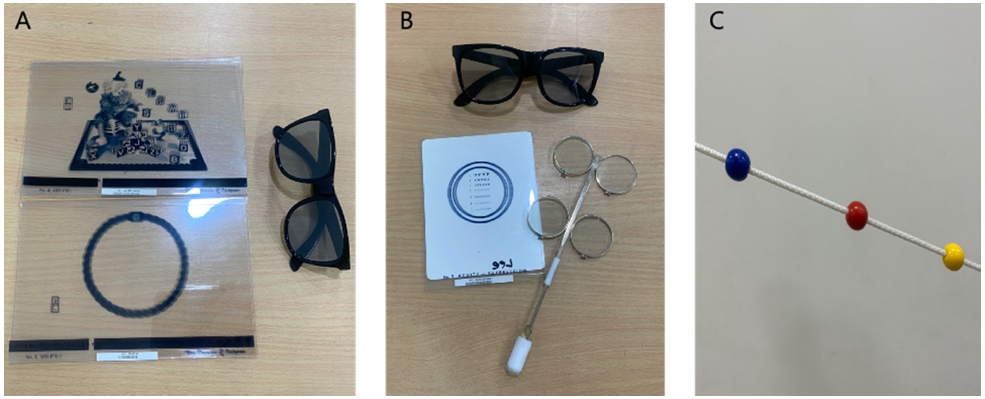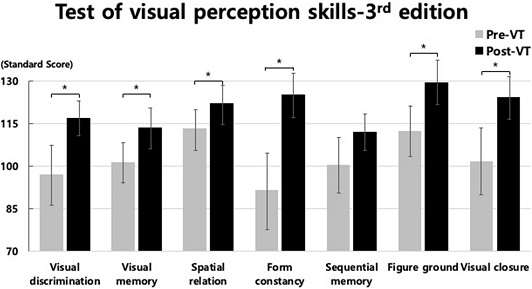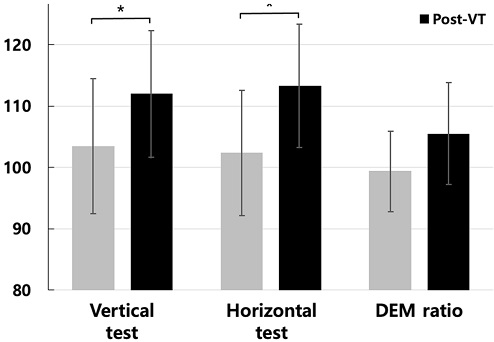
시기능훈련을 통한 시각정보처리기술의 향상 효과

초록
이 연구는 학령기아동의 학습장애에 대한 시기능훈련을 제공하고 시각정보처리기술의 변화와 시지각, 안구운동성 및 시각-운동협응이 읽기, 쓰기 및 산수연산능력에 미치는 영향을 조사하였다.
한국시기능훈련희망센터에서 학습장애 아동 13명에게 시기능훈련을 실시하였다. 시기능훈련 전과 후에 시기능평가, 시지각평가, 안구운동성평가, 시각-운동협응평가를 하였다. 시기능훈련 전과 후의 표준점수를 비교 및 분석하였다.
시기능훈련은 조절력, 조절용이성, 눈모임근점, 버전스용이성, 입체시에서 향상을 보였다. 시지각기술은 형태항상성, 시각폐쇄, 형태배경, 시각식별, 시각기억 및 공간관계 순서로 크게 개선이 되었지만 순차적기억은 유효한 결과를 나타내지 못했다. 안구운동성은 수직평가 및 수평평가에서 상당한 개선을 보인 반면 DEM비에서 미미한 결과를 보여주었다. 시각-운동협응은 크게 개선되었지만 하위평가인 시지각과 운동협응에서 크게 개선되지 않았다.
시기능훈련은 시기능 개선을 위한 훈련일 뿐만 아니라 시각정보처리기술 및 기초학습능력을 향상시키고 학습장애로 고통 받는 학령기 아동에게 도움이 된다.
Abstract
This study aimed to provide vision therapy for school-aged children with learning disabilities and to investigate the changes in visual information processing skills and the effects of visual perception, eye movement, and visual-motor integration on reading, writing, and arithmetic abilities.
The Korea Vision Therapy Heemang Center provided vision therapy to 13 children with learning disabilities. Visual function tests, visual perceptual skills tests (TVPS-3), developmental eye movement tests (DEM), and visual-motor integration tests (VMI) were conducted before and after the vision therapy. Standard scores were compared and analyzed before and after vision therapy.
Vision therapy improved visual functions such as accommodation, facility of accommodation, convergence, facility of vergence, and stereopsis. Visual perceptual skills showed significant improvements in the order of form constancy (CON), visual closure (CLO), visual figure-ground (FGR), visual discrimination (DIS), visual memory (MEM), and spatial relationship (SPA); however, sequential memory (SEQ) showed insignificant results. Eye movement showed significant improvement in horizontal and vertical tests, while the DEM ratio showed insignificant results. Visual-motor integration (VMI) showed significant improvement, but sub-evaluations such as visual perception (VP) and motor coordination (MC) only showed slight improvements that were not significant.
Vision therapy not only improves poor visual functions but also improves visual information processing skills and basic learning skills, and is helpful for school-aged children with learning disabilities.
Keywords:
Vision therapy, learning basic skills, Visual perceptual skills, Eye movement, Visual-motor integration키워드:
시기능훈련, 기초학습능력, 시지각기술, 안구운동성, 시각-운동협응서 론
시기능은 시력, 조절, 버전스, 안구운동 등 기본적인 시각활동을 위한 능력이다. 시기능의 저하로 인해 원거리 및 근거리를 주시할 때 흐림, 복시, 잔상 등의 증상을 경험하거나, 단안 주시를 하는 경우가 있다. 이러한 경우 학습 시에 책을 집중해서 읽는데 어려움을 겪으며, 이해력이 저하되어 학령기 아동의 학습에 부정적인 영향을 미칠 수 있다.[1-3] 이러한 시기능문제는 난독증(dyslexia)이나 주의력결핍행동과잉장애(attention deficit hyperactivity disorder)와 함께 더 큰 문제를 야기할 수 있다.[4,5]
시기능훈련은 시기능이상자를 대상으로 전 연령에서 시기능개선을 위한 효과적인 방법으로 사용되고 있다.[6] Scheiman외 다수의 최근 연구에서 시기능훈련의 효과를 과학적으로 증명한 연구가 지속적으로 발표되고 있다.[7-10]
시각정보(visual information)란 시각으로 얻는 모든 종류의 정보를 말하며, 보고 느끼는 공간, 지각 및 감정 등을 포함한다. 눈으로 본 정보는 뇌로 전달되어 인식하고 분석하며 또 다른 정보를 창출한다. 이를 시각정보처리라고 하며, 입력된 시각정보의 처리는 학습활동과 관련성을 가진다.[11] 이러한 시각정보는 초기의 학습 단계인 언어습득에서 특정한 단어 형태를 배우고 말한 것을 형태로 기억하는데도 중요한 역할을 한다.[12]
시각정보를 획득하고 처리하는 과정이 늦거나 이상이 발생하면 학령기 아동은 학습활동에서 많은 어려움을 겪게 된다. 외부로부터 받아들이는 정보의 80% 이상이 시각을 통해 이루어지고 있으며,[13] 학령기 아동의 경우 일과의 대부분이 보고, 듣고, 정보를 습득하는 일로 이루어져 있다. 이들은 60%에 가까운 시간을 독서, 작문 및 기타에 소비하고 있는데, 한국의 초등학생의 경우 하루 평균 5.3시간에서 고등학생의 경우 평균 7.6시간을 소비하고 있는 것으로 알려져 있다.[14] Van Garderen의 선행 연구에서 영재아동군은 학습장애 아동보다 시각정보화가 월등히 높은 것으로 밝혀졌으며,[15] 시각정보처리기술이 저조한 학령기 아동은 학습에 어려움을 겪는 등 학습장애를 나타낸다.
시각정보처리기술은 눈으로 받아들인 정보를 처리하는 만큼 시지각과 밀접한 연관이 있다. 선행 연구에서 시기능 평가에서 검사 기준에 부합하는 아동이 부합하지 못한 아동에 비해 성적이 우수하다는 결과를 도출했고, 또한 시기능평가 우수 아동은 시지각평가 성적도 우수한 것으로 나타났다.[16,17]
지금까지 시기능훈련 후 시각정보처리기술에 대한 연구가 활발하게 진행되어 왔으나, 세부 분야인 시지각, 안구운동성, 시각-운동협응의 각 기술에 대한 상관성의 연구가 미흡하였다. 따라서, 본 연구에서는 시기능이상이 있는 학령기 아동을 대상으로 포괄적인 시기능검사를 통한 시각정보처리기술의 변화에 대한 상관관계를 확인하고, 시각정보처리기술의 변화에 따라 읽기, 쓰기 및 산수연산에 미치는 영향에 대해 알아보고자 한다.
대상 및 방법
1. 대상
본 연구는 한국시기능훈련희망센터(대구)에서 학습장애증상으로 내원한 아동을 대상으로 하였다. 남자 8명(61.00%), 여자 5명(39.00%)로 총 13명(12.05±2.80세)을 대상으로 상담 후 시기능평가를 실시하였으며 시기능훈련을 진행하였다. 모든 대상자와 부모 한 명에게 연구에 대한 설명을 하고 동의서를 받았다.
2. 방법
양안시평가는 피검자 간의 검사 환경에 따른 오차를 줄이기 위해 동일한 조도와 검안실에서 이루어졌다. 검사자 간의 검사 방법에 따른 오차를 줄이기 위해 동일한 검사자가 검사를 진행 하였다. 모든 원거리 및 근거리 검사는 최소 굴절력 최대 교정시력을 가지는 도수로 처방되고 평가가 이루어졌다.
조절력은 Donder’s의 Push-up 방법으로 평가하였다. 조절용이성은 조절락카드(Accommodative rock cards, Bernell, USA) 20/30 시표와 플리퍼 ±2.00 D를 사용하였다.
눈모임근점은 주시타겟(Fixation stick, Bernell, USA)을 이용한 Donder’s push-up 방법으로 측정하였다. 버전스용이성은 단안 억제 방지를 위하여 편광시표(Fixed vectogram, Bernell, USA)와 BI 8△/BO 8△플리퍼를 사용하였다. 조절과 버전스에 관련된 이상 증상의 기준은 Scheiman과 Wick[18]가 정립한 기준으로 하였다.
입체시는 란돗 입체시표(Randot stereotest, Stereo optical, USA)를 사용하였다.
시지각평가는 TVPS-3(Test of visual perceptual skills-3rd edition, ATP Assessments, USA), 안구운동성평가는 DEM(Developmental Eye Movement TestTM, Bernell, USA), 시각–운동협응평가는 Beery VMI(Visual–Motor Integration, Pearson, USA)를 사용하였다.
시지각평가는 시각식별(visual discrimination, DIS), 시각 기억(visual memory, MEM), 공간관계(spatial relationship, SPA), 형태항상성(form constancy, MEM), 순차적기억(sequential memory, SEQ), 형태배경(visual figure-ground, FRG), 시각폐쇄(visual closure, CLO)의 7개 하위평가로 구성되어있다. 시각식별은 물체의 위치나 모양, 형태, 색상과 같이 물체의 우세한 특징을 식별하는 능력이고, 시각기억은 시각적으로 노출된 특정 자극을 기억하여 인식하는 능력이다. 공간관계는 시각적 공간처리능력이라고 칭하며 각 사물을 서로 관련성 있게 분류하고 자신에 대한 사물의 위치를 이해하는 능력이며, 형태항상성은 형태나 물체의 방향이나 거리, 크기에 관계없이 다양한 환경에서 같은 형태나 물체로 인지할 수 있는 능력이다. 순차적기억은 시각적으로 나열된 자료를 순서대로 회상하여 기억하는 능력이다. 형태배경은 복잡한 배경이나 방해되는 배경의 시각정보로부터 특정 물체를 구분하여 분별하는 능력이며, 시각폐쇄는 물체의 부분이 빠지거나 불완전한 형태에도 전체를 시각화하는 기능이다(Fig. 1).
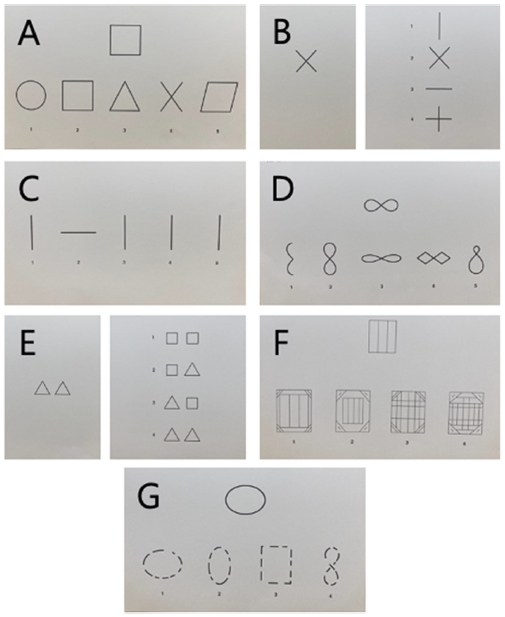
Test of visual perception skills. A: Visual discrimination (DIS), B: Visual memory (MEM), C: Spatial relationship (SPA), D: Form constancy (CON), E: Sequential memory (SEQ), F: Visual figure-ground (FGR), G: Visual closure (CLO)
안구운동성평가는 읽기-말하기의 자동성을 평가하는 수직평가 A, B와 읽기-말하기의 자동성 및 안구운동제어를 평가하는 수평평가 C로 구성되어있다(Fig. 2). 각 평가를 읽는 시간과 DEM비로 분석을 하였다. DEM비는 다음의 공식으로 계산한다.
DEM ratio = Abjusted horizontal time / vertical time
시각-운동협응평가는 본 평가(visual-motor integration, VMI)와 본 평가를 세부적으로 분석하는 시지각(visual perception, VP) 및 운동협응(motor coordination, MC)으로 이루어져있다(Fig. 3).
각 평가는 문자 대신 숫자나 형태를 사용하기 때문에 국가나 인종에 따른 문화적 차이의 영향을 받지 않는다.
시기능훈련은 한국시기능훈련희망센터(대구)에서 주 1~2회를 실시하였다. 안구운동성, 조절력 및 조절용이성 순으로 단안훈련을 진행 후 눈모임근점, 버전스용이성, 양안융합 순으로 양안훈련을 진행하였다. 시기능훈련에 사용한 도구는 Fig. 4, Fig. 5, Fig. 6에 각각 나타내었다.
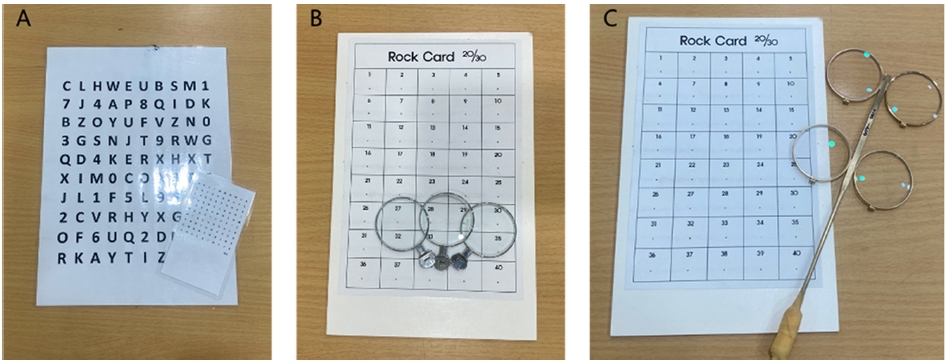
Tools for accommodation therapy. A: Hart chart, B: Accommodation rock card and loose lenses, C: Accom-modation rock card and flipper
시기능훈련 후 평가에서 Scheiman과 Wick[18]가 정립한 기준의 모든 항목에 부합될 때, 정상으로 판단하였다(Table 1). 훈련기간은 10.23±5.19개월로 개인의 수행능력에 따라 차이를 보였다.
본 연구에서 측정값은 피검자간의 나이가 동일하지 않아 원점수는 나이 차이에 따라 달라질 수 있으므로, 원점수를 만 나이로 환산한 표준점수를 기준으로 하였다. 수집된 통계 처리 방법은 SPSS ver. 22(IBM, USA)를 이용하여 사전 평가와 사후 평가의 관계는 대응표본 t-test을 하였고, 시기능의 변화와 평가항목의 관계는 pearson 상관분석을 시행하였다. 유의 수준은 p<0.05로 정의하였다.
결과 및 고찰
1. 시기능훈련 후 양안시검사값의 변화
조절력은 시기능훈련 전 평균 7.94±7.41 D에서, 시기능 훈련 후 평균 17.52±4.04 D로 유의한 향상이 되었다(p<0.001). 조절용이성은 시기능훈련 전 평균 2.86±3.23 cpm에서, 시기능훈련 후 평균 12.34±4.90 cpm으로 향상되었다(p<0.001). 눈모임근점은 시기능훈련 전 평균 16.50±11.02 cm에서, 시기능훈련 후 평균 5.46±1.26 cm로 향상되었다(p<0.01). 버전스용이성은 시기능훈련 전 평균 3.38±8.83 cpm에서, 시기능훈련 후 평균 11.00±5.15 cpm으로 유의한 향상이 되었다(p<0.001). 입체시는 시기능훈련 전 평균 95.38±105.72 arc sec에서, 시기능훈련 후 평균 38.07±34.00 arc sec로 유의한 향상을 나타냈다(p<0.05). 이상의 값은 Fig. 7에 나타내었다. 양안시검사 각 항목과 시지각평가, 시각-운동협응 및 안구운동성의 상관성을 Table 2에 나타내었다. 시지각의 시각식별, 형태항상성 및 형태배경은 조절력, 조절용이성, 버전스용이성 및 입체시와 유의한 상관성을 나타내었다(p<0.05).
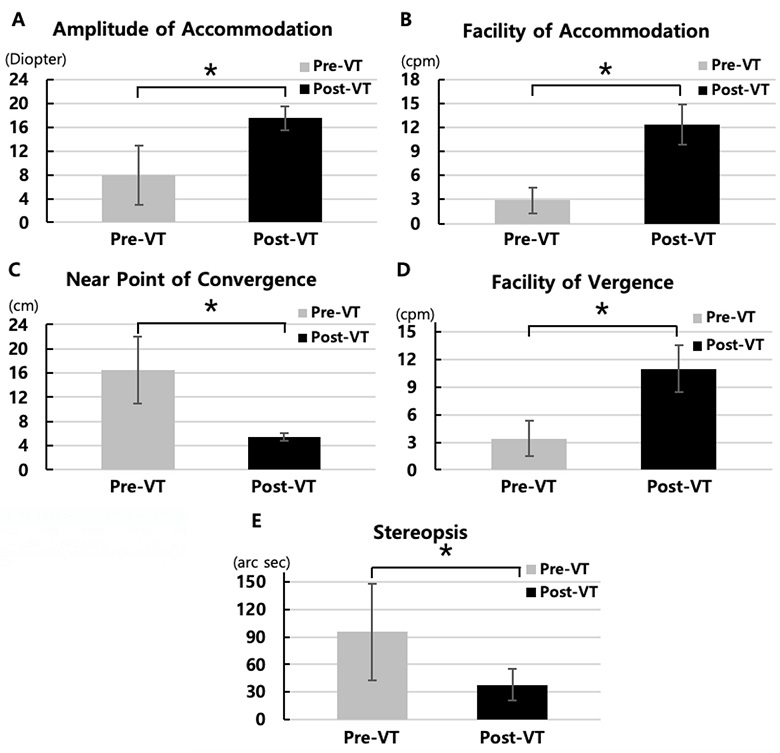
Comparison of measures before and after therapy for visual functions. A: Amplitude of accommodation (p<0.001), B: Facility of accommodation (p<0.001), C: Near point of convergence (p<0.01), D: Facility of vergence (p<0.001), E: Stereopsis (p<0.05)
2. 시기능훈련으로 향상된 시지각 및 안구운동성과 읽기 능력의 관계
형태항상성(form constancy, CON)은 시기능훈련 전 평균 86.53±36.20에서 시기능훈련 후는 평균 125.07±15.65로 7가지 영역 중 가장 큰 향상을 보였다(p<0.01). 시각폐쇄(visual closure, CLO)는 시기능훈련 전 평균 101.53±23.39에서 시기능훈련 후는 평균 124.15±15.14로 향상되었다(p<0.01). 형태배경(visual figure-ground, FGR)은 시기능훈련 전 평균 112.30±17.86에서 시기능훈련 후는 평균 129.38±15.50으로 향상되었다(p<0.01). 이외 시각식별(visual discrimination, DIS), 시각기억(visual memory, MEM), 공간관계(spatial relationship, SPA) 모두 유의하게 향상되었다(p<0.05).
순차적기억(sequential memory, SEQ)은 평균 100.38±19.08에서, 시기능훈련 후는 평균 111.92±12.50으로 유의하지는 않지만 소폭 향상되었다(Fig. 8).
조절력은 시각식별, 형태항상성, 형태배경 및 시각폐쇄와 상관성을 나타내었고, 조절용이성은 시각식별, 시각기억, 형태항상성, 형태배경 및 시각폐쇄와 유의한 상관성을 나타내었다(p<0.05). 버전스용이성은 시각식별 및 형태배경과 유의한 상관성을 나타내었다(p<0.05).
조절력 및 조절용이성에 대한 시기능훈련 결과, 훈련 전과 비교하여 훈련 후에 조절력 및 조절용의성이 유의하게 향상되었으며 시지각도 함께 향상되었음을 알 수 있었다. Nandakumar와 Leat의 연구[19]에 의하면 다운증후군 아동에게 이중초점안경으로 근용 시력을 개선하면, 단어인식과 일부 시지각평가에서 향상을 보였다. 시지각은 눈으로 본 정보를 정확하게 인지하여 습득하는 능력이고, 조절용이성은 목표물을 빠르고 선명하게 볼 수 있게 하고, 조절력은 시각적 자극을 인식하고 처리하는 동안 선명도를 유지할 수 있는 능력이다. 선명한 원거리 및 근거리시력은 더 정확하고 예민한 시지각 기술을 구사할 수 있게 할 것으로 판단된다.
시각식별, 공간관계 및 시각폐쇄에 대한 시기능훈련 결과, 훈련 전과 비교하여 훈련 후에 유의하게 향상되었으며, 안구운동성에서 읽기-말하기의 자동성 및 안구운동제어가 향상됨을 확인하였다. Pieters외 다수는 시각식별은 학습능력과 연관성을 가지는 것으로 확인하였다.[20-22] 시각식별은 시각적인 자극에서 차별성을 구분해내는 능력으로, 이 능력이 저조하면 정확한 단어를 구분하지 못하거나 유사한 단어로 바꿔 읽거나 인식할 수 있다. 공간관계도 읽기에서 읽던 단어를 빠르고 정확하게 찾거나 단어의 띄어쓰기, 쉼표 등으로 의미를 구분 짓는 데 관련이 있다. 그러나 따라보기와 홱보기로 이루어진 안구운동의 정확한 수행이 함께 수행되어져야 한다. 읽기에서 안구운동은 왼쪽에서 오른쪽으로 이동하며 다음에 제시될 단어의 초성이나 한 글자를 통해 단어 전체나 내용을 유추하는 능력은 시각폐쇄와 관련이 있고, 예측의 정확도가 저조하면 안구운동에서 잦은 홱보기를 발생시켜 읽기의 속도와 정확도를 저하시킨다.[23,24] 이 결과로 보아 시각식별과 공간관계 등 시지각능력은 읽기 능력에서 안구운동성과 서로 영향을 줄 수 있는 것으로 판단된다.
3. 시기능훈련으로 향상된 안구운동성 및 시각-운동협응과 쓰기능력의 관계
안구운동성의 변화는 시기능훈련 전의 수직평가(읽기-말하기 기능의 자동성, vertical test)는 평균 103.46±23.64에서 시기능훈련 후는 평균 112.00±22.20으로 증가하였다(p<0.05). 시기능훈련 전의 수평평가(읽기-말하기 기능의 자동성 및 안구운동 제어, Horizontal test)는 평균 102.38±21.85였으며 시기능훈련 후는 평균 113.30±21.40으로 유의한 향상을 보였다(p<0.001). DEM 비는 시기능훈련 전 평균 99.38±14.07이었고, 시기능훈련 후는 평균 105.46±17.84로 유의하지는 않지만 소폭의 증가를 나타내었다(Fig. 9).
시기능훈련 전과 후에 각 시기능의 향상은 확인 할 수 있었으나, 각각의 시기능과 안구운동성의 상관성은 유의한 관계는 없었다.
선행 연구에서 시각-운동협응은 읽기, 쓰기, 수학 연산과 유의한 확률로 연관성을 가지는 것을 확인하였다.[25] Son과 Meisels[26]의 연구에 따르면 시각-운동협응기술의 정보는 학업 미달의 위험에 처한 학령기 아동을 식별하는데 유용한 것으로 밝혀졌다. 학습에서 쓰기는 눈으로 본 글이나 귀로 들은 내용을 노트에 따라 베껴 쓰는 행위이다. 안구운동성이 향상되면 읽기에서 높은 효율을 기대할 수 있다. 이는 안구운동성이 완성되어야 정확한 정보를 입력할 수 있고, 정보를 다시 쓰기나 그리기로 옮길 수 있다. 연속적으로 주시할 때, 정확한 홱보기와 따라보기가 이루어지지 않으면 쓰기가 늦춰지거나 정확하게 옮기기 어려워진다. 시각-운동협응이 저조하면 시각 자극이 정확히 입력되어도 손으로 정확히 옮겨내는 재해석 기능이 불안정해진다. 안구운동성과 시각-운동협응의 협력에 의해 정확히 보고 옮겨내는 쓰기 능력이 행해짐을 확인하였다.
4.시기능훈련으로 향상된 시각-운동협응 및 시지각과 수학연산능력의 관계
시각-운동협응(visual motor integration, VMI)은 시기능 훈련 전 평균 102.33±8.77에서 시기능훈련 후 평균 109.25±5.89로 향상되었다(p<0.05). 시지각(visual perception, VP)은 시기능훈련 전 평균 106.25±8.49에서 시기능훈련 후 평균 109.58±5.58로 운동협응(motor coordination, MC)은 시기능훈련 전 평균 105.58±8.31에서 시기능훈련 후는 평균 109.75±3.36로 증가하였으나 유의한 차이는 없었다(Fig. 10).
시각-운동협응은 조절력과 입체시와 유의한 상관성을 나타내었다(p<0.05).
시각-운동협응에서 유의한 차이의 향상을 보였으나, 하위평가인 시지각 및 운동협응은 유의하지는 않지만 소폭의 향상을 나타내었다. 하위평가인 시지각 및 운동협응은 유의한 차이는 없었다. 이는 평가군의 연령이 평균 12.05±2.80세인 점을 감안할 때, 이 또래의 평가에서 최고 표준점수는 113으로 81%에 상응하는 수치이다. 시기능훈련 전 시지각의 표준점수는 평균 106.25±8.49이고 운동협응의 표준접수 평균 105.58±8.31로 또래의 표준집단에 비해 정상이고, 시기능훈련을 통해 향상되었으나 평가분석의 지표가 한계성을 나타내므로, 그 이상의 수준을 평가하지 못함에 있다.
선행연구에서 시지각과 운동협응의 기능은 독립적인 기술로 간주할 수 없을 정도로 연관성이 있다고 하였다.[27] 눈-손협응에 어려움이 있는 아동은 대조군과 비교하여 더 적은 수의 올바른 물체를 식별한 것으로 확인되었다. 이것은 운동성이 제한된 시지각과 신체 운동성을 포함하는 시각-운동협응이 서로 연결되어 있다는 것을 암시한다. 본 연구에서 시지각기술이 향상됨으로써 시각-운동협응의 공간과 관련된 기술들도 함께 향상되는 결과를 보였다.
연산능력은 숫자의 나열된 순으로 계산을 하거나 도형의 형태나 위치를 복합적으로 처리하는 과정으로 공간관계능력을 통해 위치와 순서를 파악하고, 시각-운동협응을 통해 손으로 순서대로 정확한 위치의 지시를 수행하여야 한다. 수학연산능력과 공간능력의 연관성을 확인할 수 있는 부분이다.
이상으로 보아 시지각과 시각-운동협응은 기초학습능력 중 하나인 연산능력과 연관이 있음을 확인하였다. 시기능훈련은 단순히 시력개선이나 안구운동과 관련된 요법이 아니고, 시지각, 안구운동성, 시각-운동협응 등의 시기능을 향상시키고, 특히 학령기 아동의 학습관련 불편을 개선할 수 있다는 점을 확인하였다.
결 론
본 연구는 학습에 어려움을 겪는 학령기 아동을 대상으로 시기능훈련을 진행하고, 훈련 전과 후의 시기능 향상에 따른 시각정보처리기술인 시지각, 안구운동성, 시각-운동 협응의 변화를 확인하고, 각 기술 간의 연관성과 기초학습능력의 연관성을 분석하였다.
연구를 통해 다음과 같은 결론을 얻을 수 있었다.
첫째, 시기능훈련을 통해 조절이상, 버전스이상 및 안구운동성을 개선할 수 있었다. 조절력과 조절용이성, 눈모임 근점과 버전스용이성, 입체시의 유의한 향상을 보였다.
둘째, 조절 및 버전스는 시각정보처리기술과 연관성을 가진다. 시기능훈련을 통해 개선된 조절능력 및 버전스능력을 통해 시지각 및 시각-운동협응의 향상을 확인하였다.
셋째, 시각정보처리기술은 기초학습능력과 관련이 있음을 확인하였다. 시지각, 안구운동성, 시각-운동협응은 개별적으로 또는 복합적으로 기초학습능력인 읽기, 쓰기 그리고 연산능력과 연관성을 가진다.
이와 같이, 시기능의 저하는 학령기 아동의 학습능력에 영향을 미치고, 시기능훈련을 통해 학습의 불편함을 개선할 수 있는 방안을 확인하는 결과를 보였다. 학습장애로 고통을 받는 학령기 아동에게 시기능의 향상으로 학습의 잠재력을 높이고, 시기능의 중요성을 확인할 수 있었다.
Acknowledgments
본 연구는 2018년도 정부(교육부)의 재원으로 한국연구재단의 지원을 받아 수행된 기초연구 사업 (No. NRF-2018R1A2B6008622) 으로 연구되었습니다.
References
-
Grisham JD, Sheppard MM, Tran WU. Visual symptoms and reading performance. Optom Vis Sci. 1993;70(5):384-391.
[https://doi.org/10.1097/00006324-199305000-00008]

- Garzia RP, Borsting EJ, Nicholson SB, et al. Optometric clinical practice guideline: care of the patient with learning related vision problems. St. Louis: American Optometry Association, 2008:7-8.
-
Jimenez R, Perez MA, Garcia JA, et al. Statistical normal values of visual parameters that characterize binocular function in children. Ophthalmic Physiol Opt. 2004;24(6):528-542.
[https://doi.org/10.1111/j.1475-1313.2004.00234.x]

-
Siegel LS, Feldman W. Nondyslexic children with combined writing and arithmetic learning disabilities. Clin Pediatr (Phila). 1983;22(4):241-244.
[https://doi.org/10.1177/000992288302200401]

- Garje MP, Dhadwad V, Yeradkar R, et al. Study of visual perceptual problems in children with learning disability. Indian J Basic Appl Med Res. 2015;4(3):492-497.
- Ciuffreda KJ. The scientific basis for and efficacy of optometric vision therapy in nonstrabismic accommodative and vergence disorders. Optometry. 2002;73(12):735-762.
-
Scheiman M, Cotter S, Kulp MT, et al. Treatment of accommodative dysfunction in children: results from a randomized clinical trial. Optom Vis Sci. 2011;88(11):1343-1352.
[https://doi.org/10.1097/OPX.0b013e31822f4d7c]

- Shin HS. The effectiveness of vision therapy for general binocular dysfunctions in primary school children. PhD Thesis. Keimyung University, Deagu. 2009;78-793.
-
Matuseviciene G, Johansson J, Moller M, et al. Longitudinal changes in oculomotor function in young adults with mild traumatic brain injury in Sweden: an exploratory prospective observational study. BMJ Open. 2018;8(2):e018734.
[https://doi.org/10.1136/bmjopen-2017-018734]

-
Hussaindeen JR, Shah P, Ramani KK, et al. Efficacy of vision therapy in children with learning disability and associated binocular vision anomalies. J Optom. 2018;11(1):40-48.
[https://doi.org/10.1016/j.optom.2017.02.002]

-
Klein S, Sollereder P, Gierl M. Examining the factor structure and psychometric properties of the test of visual-perceptual skills. OTJR (Thorofare N J). 2002;22(1):16-24.
[https://doi.org/10.1177/153944920202200103]

-
Borgström K, Torkildsen JK, Lindgren M. Visual eventrelated potentials to novel objects predict rapid word learning ability in 20-month-olds. Dev Neuropsychol. 2016;41(5-8):308-323.
[https://doi.org/10.1080/87565641.2016.1243111]

-
Anshel J. Visual ergonomics in the workplace, 1st Ed. London: CRC Press, 2002;1.
[https://doi.org/10.1201/9780203483893]

- KOSIS. Student's average learning time, 2020. http://kosis.kr/statHtml/statHtml.do?orgId=101&tblId=DT_MOBILE_STUDY&vw_cd=&list_id=&scrId=&seqNo=&lang_mode=ko&obj_var_id=&itm_id=&conn_path=K1, (21 December 2020).
-
van Garderen D. Spatial visualization, visual imagery, and mathematical problem solving of students with varying abilities. J Learn Disabil. 2006;39(6):496-506.
[https://doi.org/10.1177/00222194060390060201]

-
Wallen M, Walker R. Occupational therapy practice with children with perceptual motor dysfunction: findings of a literature review and survey. Aust Occup Ther J. 1995;42(1):15-25.
[https://doi.org/10.1111/j.1440-1630.1995.tb01306.x]

-
Goldstand S, Koslowe KC, Parush S. Vision, visual-information processing, and academic performance among seventh-grade schoolchildren: a more significant relationship than we thought?. Am J Occup Ther. 2005;59(4):377-389.
[https://doi.org/10.5014/ajot.59.4.377]

- Scheiman M, Wick B. Clinical management of binocular vision: heterophoric, accommodative, eye movement disorders, 3rd Ed. Philadelphia: Lippincott Williams & Wilkins, 2008;73-76.
-
Nandakumar K, Leat SJ. Bifocals in children with Down syndrome (BiDS)-visual acuity, accommodation and early literacy skills. Acta Ophthalmol. 2010;88(6):e196-e204.
[https://doi.org/10.1111/j.1755-3768.2010.01944.x]

-
Pieters S, Desoete A, Roeyers H, et al. Behind mathematical learning disabilities: what about visual perception and motor skills?. Learn Individ Differ. 2012;22(4):498-504.
[https://doi.org/10.1016/j.lindif.2012.03.014]

-
Forrest BJ. The utility of math difficulties, internalized psychopathology, and visual-spatial deficits to identify children with the nonverbal learning disability syndrome: evidence for a visualspatial disability. Child Neuropsychol. 2004;10(2):129-146.
[https://doi.org/10.1080/09297040490911131]

-
Mammarella IC, Lucangeli D, Cornoldi C. Spatial working memory and arithmetic deficits in children with nonverbal learning difficulties. J Learn Disabil. 2010;43(5):455-468.
[https://doi.org/10.1177/0022219409355482]

-
Rayner K, Morris RK. Eye movement control in reading: evidence against semantic preprocessing. J Exp Psychol Hum Percept Perform. 1992;18(1):163-172.
[https://doi.org/10.1037/0096-1523.18.1.163]

-
Reichle ED, Pollatsek A, Fisher DL, et al. Toward a model of eye movement control in reading. Psychol Rev. 1998;105(1):125-157.
[https://doi.org/10.1037/0033-295X.105.1.125]

-
Kulp MT. Relationship between visual motor integration skill and academic performance in kindergarten through third grade. Optom Vis Sci. 1999;76(3):159-163.
[https://doi.org/10.1097/00006324-199903000-00015]

-
Son SH, Meisels SJ. The relationship of young children's motor skills to later reading and math achievement. Merrill Palmer Q (Wayne State Univ Press). 2006;52(4):755-778.
[https://doi.org/10.1353/mpq.2006.0033]

-
Parush S, Yochman A, Cohen D, et al. Relation of visual perception and visual-motor integration for clumsy children. Percept Mot Skills. 1998;86(1):291-295.
[https://doi.org/10.2466/pms.1998.86.1.291]



